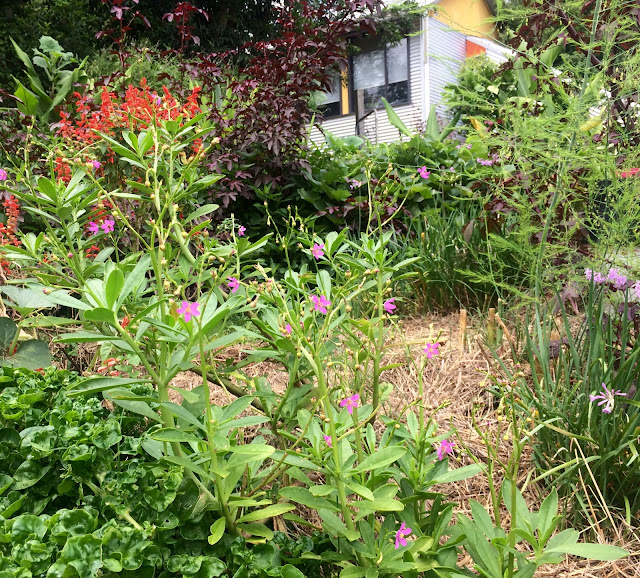Surinam spinach (Talinum triangulare) is an abundant, hardy perennial green definitely worth growing if you have a warm but semi-shaded spot in your garden. I rely on plants like this for a reliable and tasty source of diverse leafy greens in my kitchen each day.
Because Surinam spinach is so robust, pretty, easy and productive it also makes it a great plant for children's gardens, school gardens, kindy gardens, office gardens, community gardens, verge gardens ...
 |
| Surinam spinach is one of the many leafy greens that I rely on for a steady supply of greens in my garden. |
It's an attractive, low maintenance and adaptable plant to add into your garden. I'm surprised it is not more popular because it is such a nice looking plant that is easy to grow and is very productive and useful.
 |
| Easy to harvest leaves. The stems and flowers are edible too. |
Surinam spinach is found growing wild in many parts of the world. Common names are Waterleaf (90% water in it's leaf), Surinam Purslane, Florida Spinach, Philippine Spinach. It's one of the most important vegetables in Nigeria, and in Brazil it is grown along the amazon. It is found a lot around central and South America, but was originally from West Africa.
Where to grow Surinam spinach?
- Under food forest plants in moist locations, it creates a lovely living mulch once it becomes established.
- In a vegetable garden, it has some height (up to 1m) and structure, but will also tumble nicely over a wall.
- It's also great in pots, so while this is mostly a subtropical/tropical plant, it could be grown indoors in protected niches in cooler climates.
 |
| In my vegetable garden is is reaching 1m. |
In the kitchen:
The light green shiny leaves leaves are slightly tangy and have high nutrition and it's little pink flowers are edible, plus the stems and roots too. The stems, leaves and flowers ended up in a quiche last night, and last week they were one of the ingredients in my superfood pesto.
- leaves stems and flowers used raw in salad, sandwich, juices
- leaves, stems and flowers and roots cooked in stir fries, quiches, curries, stews, soups ...
Nutrition:
Surinam spinach is a rich source of vitamin C, vitamin E, Omega -3 fatty acids, iron, calcium, magnesium, soluble fibres (pectin), potassium, β-carotene, proteins and dietary fibre.
 |
| It's edible flower add lovely colour into the garden and as I took this photo, I was watching native bees visiting it. |
In the garden:
Propagating
Last week I took a cutting and just put it straight in the ground next to my lettuce, purple basil, rocket and coriander - it has struck really quickly and has new leaves already. You could also pop it in a jar of water first until it gets new leaves. It would also work well in a reasonable sized pot filled with good potting mix/compost.
 |
| I'm really impressed, the little cutting took well, despite being very hot weather and little rain. |
It is a self-seeding plant and can spread as a patch - mine has never taken off since I always have so many uses for it's abundance.
Note:
Because Surinam Spinach is high in oxalic acid, it is best to eat cooked. Also because of this, please note that if you suffer from kidney disorders, gout, and rheumatoid arthritis, you should avoid or limit your intake of this plant.
I found some interesting extra info at:
https://globalfoodbook.com/15-worthy-benefits-of-waterleaf-talinum-triangulare
http://malenyediblegardening.com.au/surinam-spinach/
https://globalfoodbook.com/15-worthy-benefits-of-waterleaf-talinum-triangulare
http://malenyediblegardening.com.au/surinam-spinach/
